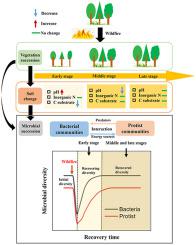Soil Biology and Biochemistry ( IF 9.8 ) Pub Date : 2021-10-04 , DOI: 10.1016/j.soilbio.2021.108452 Zhongmin Dai 1, 2, 3 , Xiaofei Lv 4 , Bin Ma 1, 2 , Na Chen 5 , Scott X. Chang 5 , Jiahui Lin 1, 2 , Xuehua Wang 1, 2 , Weiqin Su 1, 2 , Huaiting Liu 1, 2 , Yanlan Huang 1, 2 , Caixia Hu 1, 2 , Yu Luo 1, 2 , Randy A. Dahlgren 6 , Jianming Xu 1, 2, 3

|
Wildfire plays an important role in restructuring bacterial and protist taxonomic and functional communities in forest ecosystems. Yet, the recovery of bacterial and protist communities following wildfire has not been rigorously investigated across long-term wildfire chronosequences. We compared changes in bacterial and protist alpha diversity, community composition, co-occurrence networks and determinant edaphic factors between burnt and unburnt (reference) soils at 11 different sites representing a 76-year wildfire chronosequence in Canadian boreal forests. The fire increased bacterial and protist alpha diversity and altered community composition (beta diversity) as compared to the site-specific controls during the early recovery stage (<5 years since fire), but had no effect on bacterial and protist communities in the middle (8–20 years) and late (>30 years) recovery stages. Bacterial and protist communities showed similar patterns of change across the wildfire chronosequence. The post-fire recovery of bacterial communities was associated with changes in soil chemical properties (e.g., nutrient status and pH) and vegetation succession. The protist community assembly was co-influenced by changes in bacterial communities and vegetation succession/soil properties. The concurrent recovery of bacterial and protist communities, and their influencing factors of vegetation and soil properties, imply the above- and belowground living communities are strongly linked in wildfire-perturbed forest ecosystems.
中文翻译:

野火后加拿大北方森林生态系统中细菌和原生生物群落的同步和快速恢复
野火在重建森林生态系统中的细菌和原生生物分类和功能群落方面发挥着重要作用。然而,野火后细菌和原生生物群落的恢复尚未经过长期野火时间序列的严格调查。我们比较了代表加拿大北方森林 76 年野火时间序列的 11 个不同地点的燃烧和未燃烧(参考)土壤之间细菌和原生生物 alpha 多样性、群落组成、共生网络和决定性土壤因子的变化。与早期恢复阶段(火灾发生后 <5 年)的特定地点控制相比,火灾增加了细菌和原生生物的 alpha 多样性并改变了群落组成(beta 多样性),但在中期(8-20 年)和后期(> 30 年)恢复阶段对细菌和原生生物群落没有影响。细菌和原生生物群落在整个野火时间序列中显示出类似的变化模式。细菌群落的火灾后恢复与土壤化学性质的变化有关。例如,营养状况和 pH 值)和植被演替。原生生物群落组装受到细菌群落和植被演替/土壤特性变化的共同影响。细菌和原生生物群落的同时恢复,以及它们对植被和土壤性质的影响因素,意味着地上和地下生物群落在野火扰动的森林生态系统中有着密切的联系。











































 京公网安备 11010802027423号
京公网安备 11010802027423号